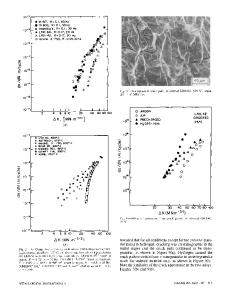Effects of temperature and environment on the tensile and fatigue crack growth behavior of a Ni 3 AI-base alloy
- PDF / 1,976,987 Bytes
- 10 Pages / 594 x 774 pts Page_size
- 43 Downloads / 361 Views
INTRODUCTION
THE Ni3A1 intermetallic has
received considerable attention due to its potential for engineering applications at elevated temperatures. Despite such attractive features as increased strength at high temperature and good oxidation and corrosion resistance, applications of polycrystalline Ni3A1 have been limited by its low ductility at room temperature. Microalloying of Ni3A1 with boron has proven to be very effective in improving ductility,rl,z] Unfortunately, Ni3A1 experiences a ductility loss when tensile tested in an oxidizing environment between 500 ~ and 1000 ~ accompanied by a transition in fracture path from transgranular to intergranular:31 An effective solution to this problem has been to alloy Ni3A1 with moderate amounts of Cr (8 pct). t3'4~ The beneficial effect of Cr may be to develop a Cr203 subscale which could reduce the severity of dynamic embrittlement. ~3] Previous studies t2~ have indicated that chemisorption of oxygen ultimately results in weakening of atomic bonding across grain boundaries. The present work examines the tensile and fatigue crack growth properties of a Ni3A1 + B alloy containing Cr and Zr. In performing this study, temperature, environment, and frequency (for the cyclic deformation tests) were the princil~al experimental variables. II.
EXPERIMENTAL PROCEDURE
A. Alloys A heat of an alloy, designated IC-221, was received from Oak Ridge National Laboratory, Oak Ridge, TN. The composition of the tested alloy is 9.0 wt pct A1, 7.97 pct Cr, 1.77 pct Zr, 0.02 pct B, and bal. Ni. The alloy was hot isostatically pressed (HIP) from prealloyed
W. MATUSZYK is with Knolls Atomic Power Laboratories, Schenectady, NY 12301. G. CAMUS, Research Scientist, is with the Laboratory of Composite Thermostructures, 33600 PESSAC, France. D.J. DUQUETTE and N.S. STOLOFF, Professors of Materials Engineering, are with the Materials Engineering Department, Rensselaer Polytechnic Institute, Troy, NY 12180-3590. Manuscript submitted July 20, 1989. METALLURGICAL TRANSACTIONS A
powders and hot extruded. The ingot was 4.4 cm in diameter by 25.4 cm in length. This material was used for both tensile and crack growth experiments.
B. Metallography and Microstructure Metallographic samples were mounted in epoxy or bakelite and then mechanically polished through 600 grit SiC paper, 9-/zm diamond paste, and a 0.3-/xm A1203 slurry. The samples were then chemically etched with Kallings reagent to reveal their microstructures. The grain size was measured using the linear-intercept technique. Heat treatments were performed in vacuum at 1150 ~ for 0.5 hours with a furnace cool to 800 ~ and a hold for 24 hours followed by a furnace cool to room temperature. The microstructure of the alloy, in the as-received condition, exhibited fine, apparently unrecrystallized grains of < 1-/xm diameter. The grain size of the heattreated material was 8/.tm (Figure 1). A slight degree of porosity was detected in the alloy, which was not surprising for a powder metallurgy product. At high magnification, a second phase was de
Data Loading...











